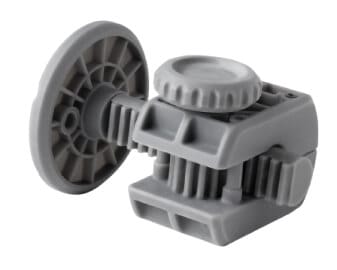Brief Introduction and History
White Standard UV Cure SLA Resin is a photopolymer material used in Stereolithography (SLA) 3D printing. SLA, one of the first 3D printing technologies developed, uses a laser to cure liquid resin into hardened plastic in a process called photopolymerization. This resin has been a staple in the SLA printing process due to its fine details and smooth surface finish.
Material Composition
This resin is composed of a mixture of monomers and oligomers – small and large molecules that form long chains during the curing process. These are mixed with photoinitiators (substances that react to light) and various additives to improve its properties. When exposed to UV light, the photoinitiators trigger a reaction that links the monomers and oligomers into a solid polymer.
Uses
- Prototyping: Ideal for creating detailed prototypes, especially where aesthetics are important.
- Jewellery Making: Used for intricate jewellery designs due to its fine detail capabilities.
- Industrial Applications: Suitable for detailed moulds or jigs.
- Art and Design: Employed in art installations and intricate design objects.
- Educational Models: Useful in creating detailed educational models and replicas.
Best Fit Use
White Standard UV Cure SLA Resin is best used for applications requiring high detail and a smooth surface finish, such as in prototyping, jewellery making, and art applications.
Detailed Example of Specific Use 1
Jewellery Making: This resin is extensively used in jewellery making for creating intricate, detailed pieces. The ability to print fine features makes it ideal for complex designs that are difficult to achieve with traditional manufacturing methods.
Detailed Example of Specific Use 2
Prototype Applications: In the manufacturing industry the resin is used to make prototypes to evaluate the functionality of a design before production. Standard resin can provide parts close to the final production parts.
Benefits
- High resolution and detail.
- Smooth surface finish.
- Capable of producing intricate designs.
- Wide range of applications.
- The most affordable SLA resin
Drawbacks
- Limited strength and flexibility compared to other materials.
- Requires post-processing (washing and curing).
- Sensitive to UV light and can degrade over time.
- Is more brittle and less rugged compared to other resins
Overall Rating for Daily Use
- Hobbyists: 4/5 (Excellent for detailed projects, but requires careful handling).
- Professionals: 4.5/5 (Highly valuable for precision applications).
Future Developments
Future developments in SLA resins, including White Standard UV Cure SLA Resin, are likely to focus on enhancing material properties like durability, flexibility, and reducing sensitivity to UV degradation. Advances may also aim to expand the range of applications, such as in biocompatible materials for medical use.




